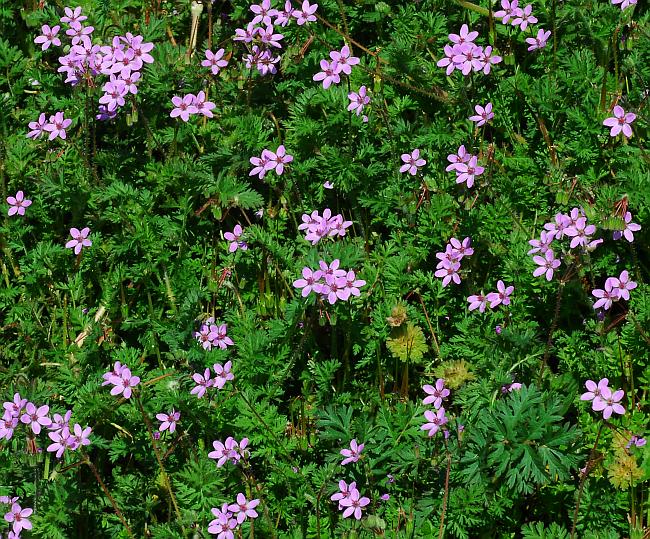Erodium cicutarium (L.) L'Hr. ex Aiton
Filaree

Introduced
CC = *
CW = 5
MOC = 13
© SRTurner
Erodium cicutarium (L.) L'Hr. ex AitonFilaree | |
 |
Introduced CC = * CW = 5 MOC = 13 |
© SRTurner |
|
Family - Geraniaceae Habit - Annual forb. Stem - Prostrate to loosely ascending, to 35 cm, often reddish or purplish tinged, moderately pubescent with spreading, minutely gland-tipped hairs.
Leaves - Basal and opposite, petiolate, pinnately compound. Blades 2-10 cm long, narrowly oblong-oblanceolate in outline, pinnately compound with 4-8 pairs of opposite leaflets, these 4-13 mm long, mostly ovate to oblong-elliptic in outline, deeply pinnately lobed, the lobes toothed or shallowly lobed along the margins, the veins and margins sometimes reddish or purplish tinged. Stipules mostly 3 at each node (by fusion of adjacent stipules on 1 side but not the other).
Inflorescences - Axillary clusters of mostly 2-5 flowers, usually appearing umbellate.
Flowers - Sepals 2.5 to 4.0 mm long, elongating to 6.5 mm at maturity, lanceolate or oblong, abruptly narrowed or tapered to a short awnlike extension at the tip. Petals 3-6 mm long, obovate, narrowed to a stalklike base, pink to pale purple. Stamens 5, the filaments free, gradually broadened toward the base. Staminodes 5, scalelike, shorter than the filaments of fertile stamens. Ovary 1 per flower, superior, of 5 fused carpels fused to a slender central column, 5-lobed toward the tip, with 5 locules. Styles 5, but fused to the beaklike central column for most of their length, persistent and becoming elongated at fruiting, the stigmas 5, club-shaped or linear. Ovules 2 per locule.
Fruits - Schizocarps, 5-lobed toward the base, splitting from the column into 5 mericarps at maturity. Mericarps 25-45 mm long at maturity, single seeded, the seed-containing basal portion 3.5-4.5 mm long, usually indehiscent, moderately to densely pubescent with short stiff ascending hairs, the stylar beak with inconspicuous short appressed hairs and separating from the column and curling and/or twisting outward at maturity. Seeds 2-3 mm long.
Flowering - March - November. Habitat - Lawns, roadsides, glades, open disturbed areas. Origin - Native to Eurasia and Africa. Lookalikes - None. Other info. - This small but pretty introduced species is not common in Missouri. Its occurrence in the state is from widely scattered locations, although most counties in the St. Louis (east-central) region of the state report its presence. It is much more common to our southwest, though it occurs in at least scattered locations across the U.S. and parts of Canada. Photographs taken along the Katy Trail in Marthasville, Warren County, MO, 3-6-2012, in Eureka, St. Louis County, MO, 4-22-2014, and at the Katy Trail trailhead in Marthasville, Warren County, MO, 3-25-2020 (SRTurner). |